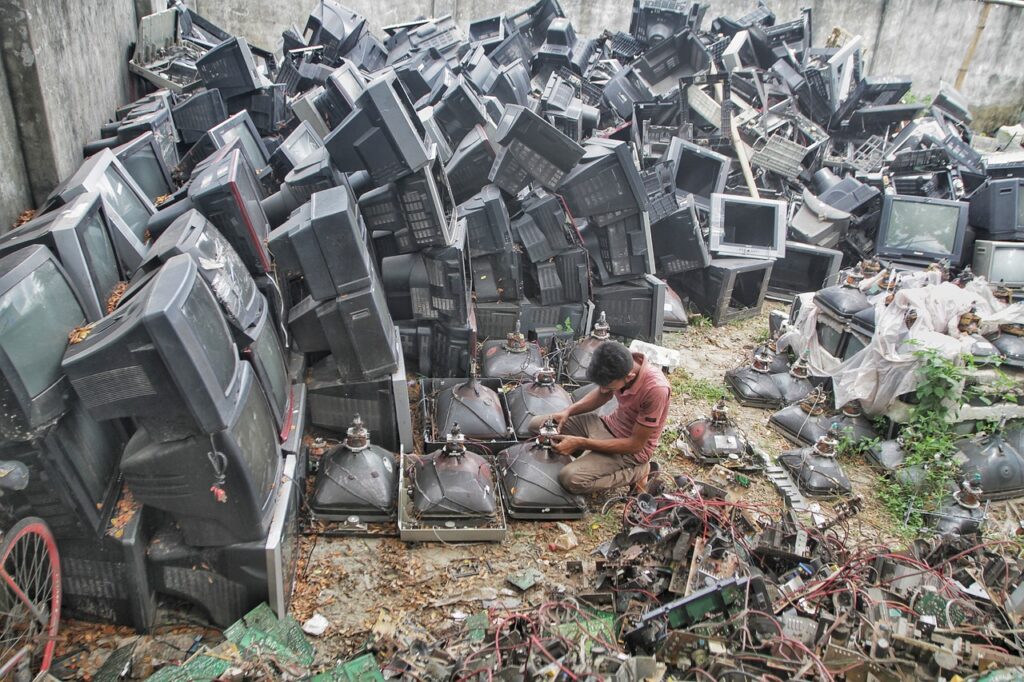In the rapidly evolving landscape of technology, the production and consumption of electronic devices have skyrocketed, leading to significant advancements in communication, healthcare, education, and entertainment. However, this surge in technological innovation has given rise to a pressing environmental issue: electronic waste, or e-waste. The improper disposal and management of e-waste have become a global concern, posing significant challenges to both the environment and human health. This blog delves into the growing problem of e-waste, exploring global trends, challenges, and potential solutions.
Understanding E-Waste
E-waste refers to discarded electronic devices and equipment, including smartphones, computers, televisions, refrigerators, and other consumer electronics. These devices contain a variety of hazardous materials, such as lead, mercury, cadmium, and brominated flame retardants, which can leach into the environment if not properly managed. Additionally, e-waste is a rich source of valuable materials, including gold, silver, copper, and rare earth elements, making proper recycling not only an environmental necessity but also an economic opportunity.
The global generation of e-waste has been steadily increasing over the years, driven by factors such as rapid technological advancements, shorter product life cycles, and the growing demand for electronic devices. According to the Global E-waste Monitor 2020, the world generated approximately 53.6 million metric tons of e-waste in 2019, and this figure is projected to reach 74.7 million metric tons by 2030 if current trends continue.
Global Trends in E-Waste Generation
Rapid Urbanization and Consumerism: The proliferation of electronic devices is closely linked to urbanization and the rise of a consumer-driven culture. As more people move to cities and become part of the global middle class, the demand for electronic devices has surged. This trend is particularly evident in developing countries, where the adoption of smartphones, laptops, and other consumer electronics has accelerated in recent years.
Shortened Product Life Cycles: The pace of technological innovation has led to the frequent introduction of new models and upgrades, rendering older devices obsolete. Consumers are encouraged to replace their devices more frequently, contributing to the growing volume of e-waste. The shift towards planned obsolescence, where products are designed with a limited lifespan, further exacerbates this issue.
Global Disparities in E-Waste Management: While developed countries generate the highest per capita amounts of e-waste, much of this waste is exported to developing nations under the guise of recycling. However, these countries often lack the infrastructure and regulatory frameworks to manage e-waste safely, leading to informal recycling practices that pose significant environmental and health risks. In regions such as West Africa and Southeast Asia, informal e-waste recycling has become a major source of income for many, despite the hazardous working conditions.
Challenges in E-Waste Management
Environmental Impact: The improper disposal of e-waste has severe environmental consequences. When electronic devices are discarded in landfills, hazardous substances can leach into the soil and groundwater, contaminating natural resources and posing a threat to ecosystems. Open burning of e-waste, a common practice in informal recycling sectors, releases toxic fumes into the atmosphere, contributing to air pollution and climate change.
Human Health Risks: The health risks associated with e-waste are alarming, particularly for workers in informal recycling sectors. Exposure to toxic chemicals, such as lead and mercury, can lead to a range of health issues, including respiratory problems, neurological damage, and cancer. Children are especially vulnerable to the harmful effects of e-waste, as their developing bodies are more susceptible to toxic exposure.
Lack of Awareness and Education: One of the major challenges in addressing the e-waste problem is the lack of awareness and education among consumers, manufacturers, and policymakers. Many people are unaware of the environmental and health risks associated with improper e-waste disposal and may not know how to recycle their devices responsibly. Moreover, manufacturers often prioritize profit over sustainability, failing to design products that are easy to repair or recycle.
Regulatory and Policy Gaps: While some countries have implemented e-waste management policies and regulations, enforcement remains a challenge. In many cases, e-waste regulations are poorly enforced, allowing for the illegal export of e-waste to developing countries and the proliferation of informal recycling practices. Additionally, there is a lack of international coordination on e-waste management, leading to inconsistencies in how e-waste is handled across borders.
Addressing the E-Waste Challenge: Potential Solutions
Promoting Circular Economy Practices: A circular economy approach to e-waste management emphasizes the importance of keeping resources in use for as long as possible. This can be achieved through strategies such as designing products for longevity, repairability, and recyclability, as well as encouraging the reuse and refurbishment of electronic devices. By extending the lifespan of electronic products, we can reduce the volume of e-waste generated and minimize the environmental impact.
Strengthening E-Waste Legislation and Enforcement: Governments play a crucial role in regulating e-waste management and ensuring that manufacturers and consumers adhere to responsible disposal practices. Strengthening e-waste legislation, improving enforcement mechanisms, and imposing penalties for non-compliance can help curb the illegal export and informal recycling of e-waste. Additionally, international cooperation is essential to address the global nature of the e-waste problem and harmonize regulations across borders.
Raising Awareness and Education: Educating consumers, manufacturers, and policymakers about the risks associated with e-waste and the importance of responsible disposal is critical to tackling the e-waste problem. Public awareness campaigns, educational programs, and corporate social responsibility initiatives can help promote sustainable practices and encourage individuals to recycle their electronic devices properly.
Investing in Formal Recycling Infrastructure: To manage e-waste effectively, it is essential to invest in formal recycling infrastructure that can safely process and recover valuable materials from electronic devices. Governments and private sector stakeholders should collaborate to establish and expand recycling facilities, particularly in developing countries where informal recycling is prevalent. This includes providing training and resources to workers in the informal sector to transition to safer and more sustainable practices.
Encouraging Manufacturer Responsibility: Manufacturers have a significant role to play in reducing e-waste through the design and production of more sustainable electronic products. Extended Producer Responsibility (EPR) policies, which hold manufacturers accountable for the entire lifecycle of their products, including disposal, can incentivize companies to design products that are easier to recycle and less harmful to the environment. Additionally, manufacturers can implement take-back programs to collect and recycle old devices, reducing the burden on consumers and preventing e-waste from ending up in landfills.
Conclusion
The growing problem of e-waste is a complex and multifaceted challenge that requires a coordinated global effort to address. As the world continues to embrace technology, it is crucial to recognize the environmental and human health risks associated with e-waste and take proactive measures to mitigate these impacts. By promoting circular economy practices, strengthening legislation and enforcement, raising awareness, and investing in formal recycling infrastructure, we can work towards a more sustainable future where electronic devices are managed responsibly, and the negative consequences of e-waste are minimized.




